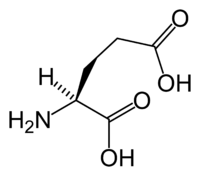
Photo from wikipedia
Astroglial excitatory amino acid transporter 2 (EAAT2, GLT‐1, and SLC1A2) regulates the duration and extent of neuronal excitation by removing glutamate from the synaptic cleft. Hence, an impairment in EAAT2… Click to show full abstract
Astroglial excitatory amino acid transporter 2 (EAAT2, GLT‐1, and SLC1A2) regulates the duration and extent of neuronal excitation by removing glutamate from the synaptic cleft. Hence, an impairment in EAAT2 function could lead to an imbalanced brain network excitability. Here, we investigated the functional alterations of neuronal and astroglial networks associated with the loss of function in the astroglia predominant eaat2a gene in zebrafish. We observed that eaat2a−/− mutant zebrafish larvae display recurrent spontaneous and light‐induced seizures in neurons and astroglia, which coincide with an abrupt increase in extracellular glutamate levels. In stark contrast to this hyperexcitability, basal neuronal and astroglial activity was surprisingly reduced in eaat2a−/− mutant animals, which manifested in decreased overall locomotion. Our results reveal an essential and mechanistic contribution of EAAT2a in balancing brain excitability, and its direct link to epileptic seizures.
Journal Title: Glia
Year Published: 2021
Link to full text (if available)
Share on Social Media: Sign Up to like & get
recommendations!